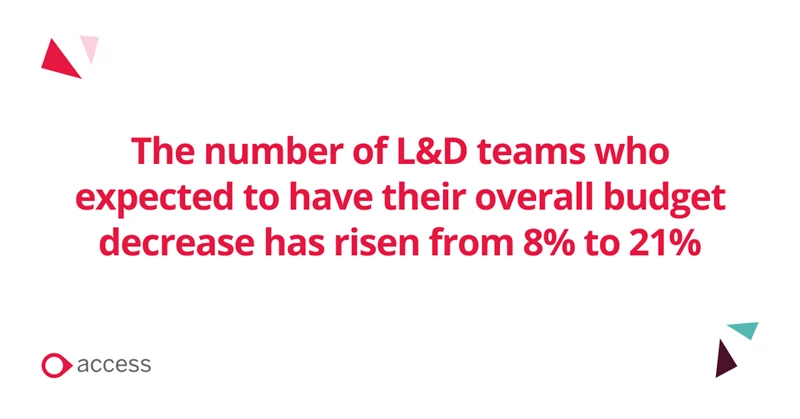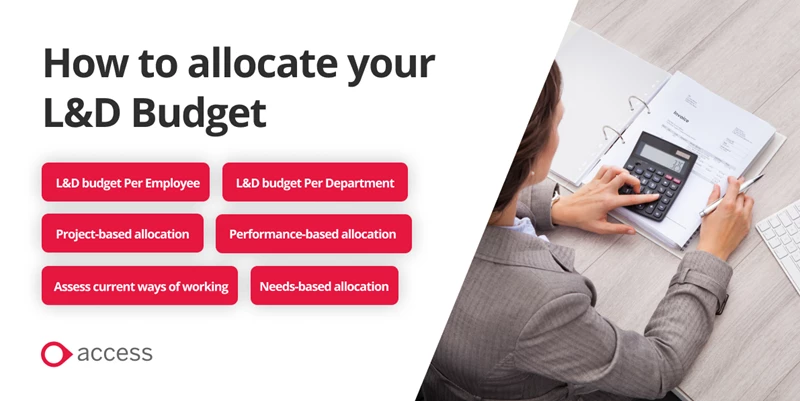-
- Learning Management System
- Learning Management System
- eLearning Courses
- Gamified Learning Solutions
- Content creation software
-
- eLearning Courses
- eLearning Courses
- Compliance eLearning
- Compliance eLearning for Financial Services
- Cyber Security Awareness eLearning
- Health & Safety eLearning
- Mental Health & Wellbeing eLearning
- Workplace Skills and Personal Development eLearning
- Online teaching resources for schools
- Self Directed Learning
-
- Career Development
- Career development for staff
- Developing student employability
- Employability Software

L&D Budgets Explored: How to make the most of your budget in 2024
Investing in learning and development (L&D) is crucial for the growth and success of any organisation. Whether you're just starting to research L&D budgets or looking for ways to optimise your current L&D strategy with wise investments, this blog will provide valuable insights and practical tips.
 7 minutes
7 minutes

Written by Mike Hadlow
In this blog, we'll explore the key factors to consider when planning how to use your L&D budget and provide you with practical tips to help make the most of your investment. We'll also highlight the different types of learning and development that companies can invest in, depending on their specific business needs and learning maturity.
So let's get started!
In this article we explore the following topics:
L&D Budgets in 2024: Navigating Challenges and Maximising Impact
When it comes to L&D budgets, it's important to take a pulse on the industry. The 2023 Fosway Report found that the number of L&D teams who expected to have their overall budget decrease has risen from 8% to 21%.
To further emphasise these findings, in their 2023 Learning at Work report, CIPD found that limited budget was one of the top three barriers to supporting organisational and people goals. These results align with the insights from the Fosway report, underscoring the considerable challenges and pressures faced by organisations in 2024 as they grapple with tighter budgets and the need for justified investments.
Now more than ever, it's essential to develop a strategic approach to budget allocation for learning.

Initial L&D Budget considerations
When it comes to allocating your L&D budget, there are several factors to firstly consider. To get started, consider these five areas:
Aligning your L&D Budget with Business goals
The first is your company's goals. This is important because it ensures that the L&D budget is being used to support the company's strategic objectives.
- What do you want to achieve through employee development?
- How will this contribute to your organisation's overall success?
By aligning L&D goals with business goals, you can ensure that the training and development is used most effectively to achieve the desired business impact.
Assessing workforce needs
You need to assess your employee development needs, to help you identify the skills and knowledge gaps in your workforce.
- What skills do your employees need to learn or improve?
- How will this benefit your business?
By understanding your employees' development needs, you can invest in training programs that will help them improve their skills and knowledge, ultimately improving their job performance and contributing to the company's success.
Resources
You need to consider your available resources, can you invest enough to get the right solutions to fulfil your ambitions and do you have the time to make the most of them.
- How much money and time can you realistically invest in L&D?
How can you optimise your investment?
Understanding ROI
You need to be able to evaluate the return on investment (ROI) of any initiative or learning tools you invest in. You need to be able to estimate, and then measure ROI.
- How will you measure the success of your training and development efforts?
- What metrics will you use?
By measuring the ROI of your training and development efforts, you can determine whether they are delivering the desired outcomes and whether you are getting a good return on your investment.
This information can then be used to refine your L&D strategy and budget over time.
How to set an L&D budget
- Identify Training Needs: Pinpoint training priorities aligned with overarching objectives.
- Allocate Budget: Determine funding for various training categories.
- Estimate Costs: Calculate expenses for content, technology, and more.
- Prioritise Impact: Rank initiatives according to their strategic value.
- Allow Flexibility: Prepare for unforeseen requirements and adaptability.
- Plan Evaluation: Allocate resources for measuring and assessing outcomes.
Download our Fosway guide on practical steps for building a compelling business case for learning initiatives.
How to allocate your L&D Budget
There are multiple L&D budget methods, and choosing the right approach can greatly impact the effectiveness of your initiatives.
1. L&D budget Per Employee
One method is to allocate a set amount of L&D budget per employee. This ensures that each employee receives an equal opportunity for development. However, this approach may not be suitable for businesses with a large number of employees, as it can be expensive, and unnecessary.
2. L&D budget Per Department
Another method is to allocate the budget per department, business unit or function. This allows you to tailor your L&D programme to the specific needs of each team. However, this approach may result in disparities between departments, with some teams receiving more investment than others.
3. Performance-based allocation
This approach involves allocating budgets based on an employee's performance. High-performing employees may receive more investment for higher level training for example, such as in preparation for leadership roles, or greater budget could go to those who need more development support.
4. Project-based allocation
This approach involves allocating your budget based on specific projects or initiatives. For example, if your company is launching a new product, you may allocate a budget for training and development related to the product launch.
5. Needs-based allocation
This approach involves allocating your budget based on the specific needs of employees or teams. For example, if a particular team needs to develop their digital marketing skills, you may allocate a budget specifically for digital marketing training.

Which L&D budget allocation method is best?
The key is to find the right balance between equal investment and targeted investment that aligns with your business goals.
You can take a hybrid allocation approach. This approach involves combining different allocation methods to create a comprehensive L&D programme that meets the needs of your organisation.
For example, you may allocate a set amount per employee for mandatory training, or a set amount to cover the whole organisations needs of mandatory training, to cover the content and software to enable this, and then also allocate additional funds based on performance, project needs, or specific team needs.
When allocating your L&D budget, it's important to weigh the pros and cons of each approach and determine what will work best for your organisation.
Where to invest your L&D budget?
1. Learning Management Software
By investing in LMS software, companies can benefit from structured and guided training programmes.
2. eLearning Courses
Offering a variety of eLearning courses can help your organisation achieve regulatory compliance for your industry and empower your talent to learn the way they want to.
3. Personalised Learning
Tailoring the learning experience to individual employees' needs and preferences is crucial
4. Self-Directed Learning
Encouraging employees to take ownership of their learning journey can be highly effective.
Investing in an LMS, eLearning Courses, Personalised, and Self-Directed learning modules can bring significant benefits to a company's L&D efforts, but the decision to invest in these areas should be based on the organisation's learning maturity and specific needs.
Companies with a low learning maturity may benefit most from investing their Learning and Development budget initially in eLearning courses hosted on an LMS, which focuses on meeting compliance and other mandatory training requirements.
As the organisation's learning maturity increases, personalised and self-directed learning modules should be considered as part of your budget allocation. These are the areas where investment is needed to create more engagement in learning experiences that align with overall business objectives.
For example, a company with a strong culture of learning and development may find that investing in personalised learning plans tailored to individual employees' needs leads to increased engagement and higher levels of skill development and retention.
Investing learning and development budget in self-directed learning resources gives employees the flexibility to take ownership of their learning and build expertise in areas that interest them. This is the type of learning that leads to the greatest satisfaction.
Consider an LMS Budget
If you don’t already have one, or you need an upgrade, investing in a great LMS should be an essential component of your L&D budget usage.
An LMS can do the below, and more:
-
- save countless hours of administration time
- streamline your training programmes
- target learning
- track the progress of your employees
- record CPD training & compliance training
Having a dedicated LMS budget is likely to take up a chunk of your funds, and so does require careful consideration, we recommend reading "How Much Do Learning Management Systems Cost?".
By earmarking an LMS budget, you can make your funds go further. Investing in a Learning Management System can save your business money in the long run by providing a cost-effective solution to traditional training methods.
Traditional methods can be expensive, particularly when you factor in costs such as instructor fees, travel, and time away from work. Moreover, it can be difficult to measure the success of these methods and their return on investment.
In addition, through an LMS you can update and modify training content in real-time, ensuring your employees have access to the latest, most relevant information.
When rolling out clearly targeted learning aligned to business initiatives a good LMS enables you to target specific audiences and measure learning adoption and impact. Without this it becomes so much harder to build the case for learning budgets”
Learning and Development Budgets in 2024 Summary
Modern Digital Learning technology has revolutionised the way companies approach employee development. Now in 2024, you are offered cost-effective solutions that can maximise the value of your Learning and Development budget.
By providing effective digital learning solutions companies can save money on training while offering their employees learning options that align with business goals.
L&D technology will allow you to better track employee progress and evaluate ROI, enabling you to make informed decisions on future investments.
With the right technology in place, you can optimise your Learning and Development budget and unlock the full potential of your people.





